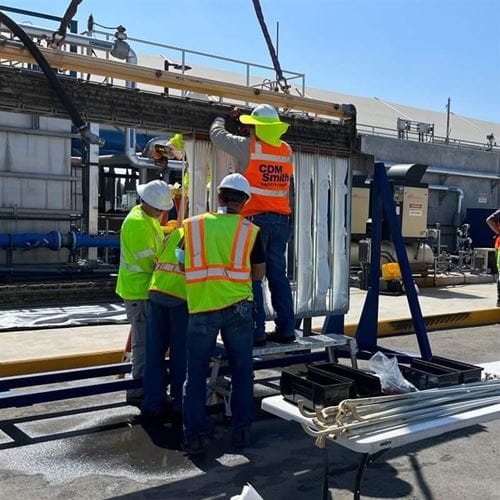Potable Reuse Applications for Membrane Bioreactors
Membrane bioreactors (MBRs) have been used since the early 2000s in North America as a reliable wastewater treatment process. More recently, MBRs have been considered for potable reuse applications. Anthony Zamarro, discipline leader for MBRs, gives his take on potable reuse applications, how they clean water, design elements and more.
Why are MBRs being applied to potable reuse projects, and what benefits do they offer?
MBRs are a great enabling technology. They excel at removing pathogenic species from human sanitary waste streams. These pathogens, such as bacteria and viruses, pose health risks and need to be eliminated. And by effectively filtering out particles on the scale of 1 to 3 microns, MBRs significantly enhance water quality and produce crystal-clear effluent! Many times, I’ve witnessed people react in surprise to how pure the water appears coming out of an MBR, especially considering that your starting point in wastewater is dirty water filled with pathogens and unwanted chemicals.
Direct potable reuse projects involve treating as many as 250 different constituents. While MBRs are removing some of the worst contaminants that we’re aware of, they also pave the way by creating that crystal-clear effluent that an advanced treatment train can act on. Then technologies like reverse osmosis and advanced oxidation come into play, ensuring safe and clean water for consumption. MBRs act as a vital bridge between initial pathogen removal and the comprehensive purification needed for potable water reuse.
While MBRs represent just one piece of the direct potable reuse puzzle, they play a crucial role in enabling projects to scale successfully.
How do you measure how well an MBR is cleaning water?
MBRs are very efficient at removing particles, particularly those larger than one micron, which are most prevalent in a domestic waste stream. But MBRs are made of polymeric materials that aren’t bulletproof, so they can develop defects that can lead to reduced efficiency.
They operate in a high-solids environment, which sets them apart. While a typical membrane works with around 100 parts per million (ppm) of solids (a direct filtration process), membrane bioreactors function at a much higher scale—about 8,000 to 10,000 parts per million. This magnitude difference creates what we term a “dynamic filtration environment.” In this environment, the solids surrounding the membrane form a filtration layer. As researchers explored filtration mechanisms, they discovered that the membrane itself performs filtration, while the solids create an additional layer—a “cake layer”—around the membranes that provides filtration, protection, and helps seal any defects. However, fouling dynamics occur, where chemicals deposit on the membrane surface, and these solids prevent these chemicals from directly affecting the membranes. So, it’s a complicated process and when verifying the effectiveness of this barrier, we must consider these secondary mechanisms where filtration occurs.
In California, regulators are currently developing a three-tiered framework to assess membrane performance. This framework considers various aspects of membrane operation and assigns what are known as “log removal credits.” These credits measure how effectively a system removes bacteria, viruses, and other contaminants. For instance, a single log removal credit indicates 90% removal, while two logs correspond to 99% removal. The level of credit depends on the system’s tier and the investment in its operation.
Even at Tier 1, MBRs are very robust and achieve two and a half logs of removal of protozoa. Membrane technologists take pride in this performance, and it should instill confidence in both engineers and people who consume this water.
Who could benefit from incorporating an MBR into treatment plans?
Believe it or not, treating wastewater is more feasible than expanding potable water sources for industrial facilities in most cases. I anticipate we’re going to see business enterprises be more willing to invest in expanding or modifying existing treatment systems so they can gain access to beneficial wastewater use.
Another area of growth for MBRs is addressing water scarcity, particularly in the Southwest. Over the past two decades, discussions around wastewater reuse have evolved from conceptual to real life. I’ve always said, reuse is always “a great idea” until it becomes an emergency, then it becomes real very quickly. California has been at the forefront of wastewater reuse, having recognized the need to recycle treated wastewater and construct numerous water recycling plants over the past decade. Looking ahead, states like Texas, Arizona, and New Mexico – areas facing population growth – will likely need to adopt potable reuse solutions, leading to a surge in MBR projects.
Anthony has worked in membrane technologies and treatment systems for more than 20 years with a focus on membrane bioreactor (MBR) systems. He has experience in system design, value engineering, system startup, and process troubleshooting. He has also been involved in the application of MBR systems for advanced treatment trains, including indirect and direct potable reuse (IPR/DPR) applications. If you're seeking guidance or want to learn more, reach out to Anthony today.

Looking ahead, states facing population growth will likely need to adopt potable reuse solutions, leading to a surge in MBR projects.








